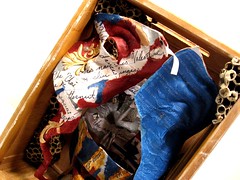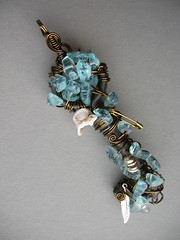So, you may remember that Mike Allen had a Kickstarter for Clockwork Phoenix 4, and that his $10K goal, which he made, was that he’d start a new magazine. He hit the goal, and we all got a little ridiculous on Twitter.
*******
Me: Hey @mythicdelirium when do submissions open for your BRAND NEW MAGAZINE because I have a thing about a vampire& a werewolf who fall in love
@rose_lemberg: vampire and werewolf fall in love with a DEMON. And a witch. It is poly.
Me: ALSO THERE ARE ANGELS AND SELKIES. And everyone is noncreatively pseudokinky. PUBLISH ME.
@time_shark: oh do you now? (patience grasshopper)
Me: Ha! No. No, I do not.
@time_shark: I’m curious if someone could write a story like that I’d actually buy. [NO that is NOT a challenge…]
Me: …damn you. *chases plotbunny*
*******
I did not chase the plotbunny at that time. At that time, I was going wild on Twitter to distract myself from the fact that our cat was dying and my grandmother was having the same symptoms as the cat. Besides, I had a totally different idea for my CP4 submission, something that would really bend storytelling in weird ways…
…something that I just couldn’t get started on. I needed to do research for it, et cetera. In the meantime, life was collapsing in on me and I kept getting little story-sparks for this thing. Could I write a story like that that Mike would buy? Doesn’t matter, I have five other things to do first. But what if – NO, brain, stop it, that is last in the queue!
But in the middle of the hell time, I sat down and wrote it anyway.
My characters have ridiculous names. I crisscross five different genres. I hoped the story wouldn’t get rejected on formatting alone, because I Did Things. But I wasn’t writing to make it pretty and publishable. I was in the center of the whirlwind and it was my damn rope. And it didn’t matter if anyone else liked it, because dammit, it made me laugh when I didn’t think I could. And whenever I had time, whenever I wasn’t medicating the cat or flying to Florida or dealing with my now-ex cheating on, lying to, and emotionally terrorizing me, I would sit and say “it’s okay if you only do a hundred words today, but you have to do a hundred words.” No drowning allowed. I was writing with a strict set of guidelines because that’s what I needed, but I had no idea if it would work for anyone but me, and I didn’t need it to. I needed to be ludicrous and break all the boxes and build something new.
So I wrote it.
I sent it to my husband and he said it was my best story yet and y’know, I think I agree. It’s my longest. It is not grimdark. There are parts that make you laugh and parts that make you go oooh and sometimes those are the same parts.
So I sent it to Mike. And he bought it, this story about a vampire and a werewolf in LOVE and there’s a witch and an angel and an alien stripper and there are zero straight people in it and two genderfluid characters and a new drink and karaoke and discredited scientific theories.
And it all starts when a vampire and a werewolf walk into a bar.
(The witch is already in the bar.)
You should buy Clockwork Phoenix 4 is what I am saying, I guess. And Mike, thanks for the challenge. 🙂
“Happy Hour at the Tooth and Claw” was published in Clockwork Phoenix 4. It has been reprinted online at Mythic Delirium, and it is on Tangent Online’s 2013 Recommended Reading List.
—–
Louis West at Tangent Online says: “Shira Lipkin’s “Happy Hour at the Tooth and Claw†is an incredible love story about Zee, a witch who can flip through realities like reading a book, who violates the laws of physics by thinning boundaries between worlds because she’s bored, and who long ago hid her heart to avoid the pain. Cast in a poetic, screen-play type style, at places the structure of the story morphs because a character doesn’t like the way Zee first portrays them. Hiding her heart made her inviolate and immortal. But Zee is “apocalyptically bored,†and “bad things happen when beings who can smash together universes get bored.†Hesitantly, she comes to the decision that perhaps it’s time to find and reassemble the pieces of her heart, only to learn that the most crucial pieces never left her. The ending changes the story, and everyone in it, allowing me to discover a brand new tale upon rereading it. Exceptional and highly recommended.”
Dusty on Movies says: “One of my favorites, Shira Lipkin’s story follows a playful witch who flips through dimensions like they’re TV stations. Along the way she develops a relationship with a bar-keeping angel and a mysterious courtesan. She also casts a spell of love between a female werewolf and female vampire, who of course have all sorts of compatibility issues but love each other nonetheless. It’s a story with heart, literally. Our witch has hidden her heart to increase her power, but now she’s on a quest to find the pieces she’s hidden throughout the multiverse. This is a truly fun story. There’s a gimmick with the text alignment that adds to the fun. I’ll let you discover it for yourself. I’m a huge fan of this story.”
Just Book Reading says: “A witch who can switch between realities and is happy to play around with the boundaries of love but shies away from her own heart. Zee, the witch, is such an intriguing character and I love how she plays around with everyone else’s heart and ignores her own. It’s a keeper and by that I mean it’s another favorite.”
Michelle Anjirbag at Cabinet des Fees says: “a new kind of love story, in part inspired by a challenge by the editor himself. What makes a heart whole?”



